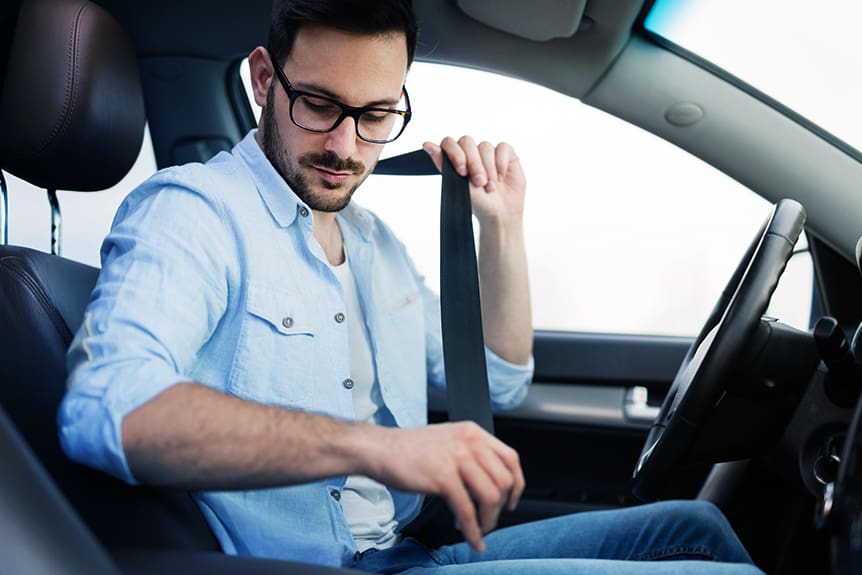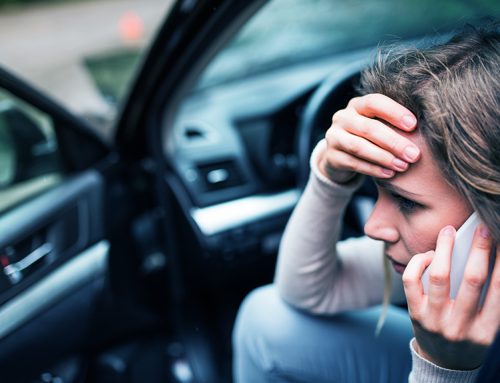Safety and Financials: The Consequences of Not Wearing a Seatbelt

In every state but New Hampshire, seatbelts are mandatory for adults sitting in a front car seat. Seatbelts are also mandatory for children, regardless of which state they are in.
In 2017, 47 percent of the people killed in motor vehicle crashes were not wearing seatbelts, and 14,955 passengers survived crashes simply because they were strapped in. An additional 2,549 fatalities could have been avoided if everyone had been wearing seatbelts.
The Consequences of Not Wearing a Seatbelt: Personal Injury to Drivers and Passengers
While seatbelts can cause some bruising and other injuries in a crash, the consequences of not wearing a seatbelt are often far more severe.
Abdominal, skeletal, vascular, and thoracic injuries—such as whiplash, concussions, bone fractures, musculoskeletal damage, internal bleeding, and more—are the most common injuries that result from car accidents. Many people endure long-term complications, sometimes months—if not years—after an accident.
The emotional response to surviving a traumatic car crash can also affect a patient’s quality of life. PTSD, anxiety, depression, and changes in personality due to traumatic brain injury are all common results of motor vehicle collisions.
Some injuries cannot be fully healed and result in lifelong pain or loss of function. The ones that can be healed can still come at astronomical costs.
The Consequences of Not Wearing a Seatbelt: Higher Medical Costs
Unrestrained car accident victims tend to need more costly medical care. Potential mental illness and emotional trauma aside, the consequences of not wearing a seatbelt cost about $44 billion in 2013 alone. This sum includes medical bills as well as the financial burden of families’ loss of wages when a family member was seriously injured or killed in a car accident.
Hospitalization can be very expensive and easily break the bank for the average U.S. citizen. Studies indicate that hospital visits are more often required for unrestrained accident victims. The length of these victims’ hospital stays is also typically longer than those who were wearing seatbelts when they were involved in a car crash.
The Consequences of Not Wearing a Seatbelt: Death of Drivers and Passengers
Automobile accidents are a leading cause of death among people aged one to 54 in the United States, and seatbelts can cut serious injuries and deaths from car accidents in half. While refusing to wear a seatbelt puts passengers at a higher risk of serious injury or death, the consequences of not wearing a seatbelt also extended to other passengers in the car—regardless of whether they themselves are wearing seatbelts or not.
Human Collision
During a car crash, there are actually three different collisions that occur. The first is the vehicle collision, which occurs when the vehicle hits another object. The second is the human collision, which is when the passengers hit objects within the car. And the third is the internal collision, and occurs when the passengers’ internal organs keep moving forward within the body—this is how internal injuries occur.
When a vehicle crashes, its occupants continue moving at the speed that the vehicle was traveling until something stops them. For restrained passengers, that object is usually the seatbelt—or, for front-seat passengers, the airbags. But for unrestrained occupants, that object could be the seat in front of them, the front windshield, or even other passengers.
During human collision, passengers that are not wearing seatbelts become projectiles and put themselves and other vehicle occupants at risk. In fact, one study found that vehicle occupants exposed to unbelted passengers during a motor vehicle collision are at a 40 percent increased risk of injury. Wearing a seatbelt in the car is an important safety measure for the collective well-being of the car’s occupants.
These consequences of not wearing a seatbelt can be easily avoided in most cases with a simple restraint that you have at your disposal. The United States government details what kind of restraints are safest for each type of vehicle.
The Consequences of Not Wearing a Seatbelt: Reduced Personal Injury Settlements
Even though most of the U.S. has rules in place that restrict lawsuit settlement amounts in car accident cases, the statutes are far from uniform.
More than a dozen states have legislation on the books that restricts the amounts motorists can sue for—or be awarded—if they weren’t buckled during a traffic collision. These include Oregon, Ohio, New York, New Jersey, Arizona, Michigan, Georgia, and Florida, among others.
When an accident victim doesn’t wear a seatbelt, defense attorneys can use the “seatbelt defense,” as Gary Wickert, an insurance trial lawyer and subrogation expert, describes it. Because the victim wasn’t buckled in, the defense can argue that the plaintiff should have been wearing a seatbelt and would have reduced the severity of injuries if they had done so.
In Wisconsin, for instance, up to 15 percent of injuries can be attributed to not wearing a seatbelt. In other states, the percentage of injuries that can be attributed to the lack of a seatbelt ranges from one to five percent. Although most states don’t have seatbelt defense statutes, it’s possible more could pass similar legislation, as increasing amounts of evidence point to seatbelts reducing fatality risk.
While car insurance claims or personal injury lawsuits can still be filed against an at-fault driver when there is an injury, the amount awarded could be much less than it would be if the injured party had been wearing a seatbelt.
What You Can Do to Stay Safe and Maximize Your Settlement
More and more evidence points to the consequences of not wearing a seatbelt, which include increased fatality and injury risk. Thanks, in part, to automakers going to greater lengths to ensure motorists strap themselves in, most Americans do wear seatbelts. In fact, in 2019, NHTSA estimated that over 90 percent of motorists used seatbelts regularly—the highest compliance rate on record.
However, according to research conducted by the CDC, people who live in rural locations are less likely to wear seatbelts. As a result, in 2014, traffic deaths in most rural counties were three to ten times higher than most urban counties. These statistics remind us that it doesn’t matter if you’re traveling on the highway or a backcountry dirt road, it’s important for everyone to buckle up. That goes for EACH trip, EVERY time.
When it comes to your life, health, and finances, the consequences of not wearing a seatbelt are too costly and completely unnecessary with the technology we have available today.
The Importance of Wearing a Seatbelt
Just because you were not at fault in an accident doesn’t mean your case is ensured a high settlement. Each state has unique rules that can make a case complicated to present to a judge or jury on your own.
And even if you win, it may be a while before you’re compensated. If you’re seeking financial help after an auto accident, you may want to enlist professional assistance to get you the funding you need for medical bills.
Being involved in any kind of motor vehicle accident can be scary, but with the right knowledge on your side, you can be prepared for anything. While Glofin does not offer auto accident loans, our presettlement funding services help you cover your expenses for your personal injury lawsuit.



